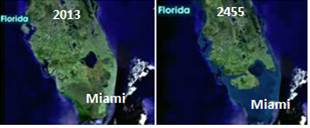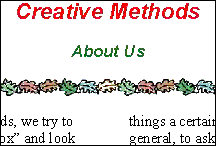Creative Methods
"Outside the Box" Perspective for Fundamental Issues
![]()
|
Welcome to Creative Methods, providing scientific analyses for fundamental
issues of our world. Short descriptions of the topics in the site are below. [Clicking the blue underlined topic title, or the picture, or the “Go” button opens the topic. Use your browser’s “Back” arrow/button to return here. Return links and navigation bars at the bottoms of pages facilitate movement throughout the site.] |
Global Temperature Increases
|
Global Warming will increase temperatures by about 6.9 degrees Fahrenheit, or 3.9 degrees Celsius, during Fossil Fuel Lifetime, until fossil fuel runs out in about 2240. The earth will experience a Climate Change and will revert to a mild climate similar to that of the Oligocene period of 23 to 34 million years ago. Polar ice will slowly melt to produce a Sea Level Rise of a few millimeters a year, which will reach 20.0 feet or 6.10 meters above the level of July 1, 2013 by about 2455. The current national and international policy of "reducing emissions" is futile because it only delays by a few years when the fuel is burned and only slightly alters the path to the eventual outcome. |
US Air
Quality Gradebook
|
US Air Quality Gradebook presents a composite view of air quality based on 21 measures from the Environmental Protection Agency (EPA). Maps and gradesheets grade US counties from A to F on 10 measures of ambient concentration and on emissions of 11 pollutants. Each county then receives a composite grade based on these 21 individual measures. Air quality in neighboring counties also influences a county's map grade. |
Español |
Spanish is an increasingly important language in the United States. About 14 percent of the U.S. population now has Hispanic background, and by 2050 that will increase to 29 percent. Especially in much of southwestern United States, it is a distinct advantage to know both English and Spanish. This section contains some good references for an introductory Spanish course. |
About Us |
At Creative Methods, we examine fundamental issues with scientific analyses. In this endeavor, we employ “outside the box” perspective to provide fresh understanding of our world and ourselves. Always present is the scientific method, with its high standards of reproducable evidence. |
|
We at Creative Methods hope our site shows you a fresh, scientific perspective on fundamental issues of our world. |



